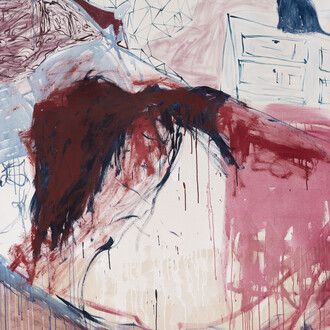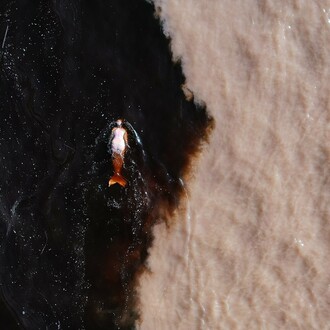Celebrating the launch of Vitrine's new public sculpture programme 'Sculpture At Bermondsey Square', Alys Williams (Vitrine Founding Director) and Karen Tang (Artist & Project Co-Founder) discuss the commissions programme and the first sculpture by Tang titled 'Synapsid', which will be exhibited in the square until March 2015.
KT: How did SABS come about - what were your initial thoughts about the project and how have these developed?
AW: As you know, Vitrine Bermondsey Square is a gallery that is public and viewable 24-hour from the square. Much of our programme has always involved public performance and events, something that the square has always embraced and I have built the space around. It's a very exciting platform for a curator and artists. It's also a space that is so right for public sculpture. As we have discussed, after the Economist Plaza commission ended, there is little space for artists creating public sculpture and commissions in this field for emerging, mid-career artists. So I started thinking about this as an idea for a project and throwing around ideas about how to get it off the ground. That's when we first talked about it and your continued commitment, engagement and understanding of the field was a perfect match for realising the ambitious project together.
AW: What do you think makes good public sculpture?
KT: Public sculpture should do something for the site that nothing else surrounding it can. Artwork does not have to be specifically practical so allows freedom in form. It should be interesting enough to captivate a wide audience and generate discussion, debate. It should not be decoration, bland space-filler, or placebo for improvements to the fabric of the space. Public sculpture can take on important functions, there is the history of monument with the responsibility of emblematically representing the cares of a society. However, it can fulfill many other roles; good public sculpture is good art that you might see without having to make a trip to a gallery.
AW: What is the importance for you of commissioning programmes of this sort and what does it allow you and your practice?
KT: The freedom SABS has given me to respond to the site creatively has been brilliant. I have been able to work on a larger scale, extending my knowledge of materials and fabrication processes. Working with the partners involved in SABS has given insight into the ways the work might be pertinent to different groups. Vitrine’s innovative gallery support has been great, throughout the development and now exposing my practice to new audiences. Commissioning programs allow me to realise work that otherwise would remain at model stage – and communicating ideas through showing sculptures is the whole point!
KT: What have been your favourite aspects of the SABS process so far?
AW: I think the moment I walked into your studio and was faced with this huge sculpture in sections. You and your assistant carving and colouring the work in parts inside and outside the space. It being so much bigger than your space. It was a wonderful experience. It was this moment that it all became very real and I had a fascinating insight to your process and how an artist approaches public sculpture production. I think one of the things I liked about this sculpture idea - when we discussed the different options you had developed as models - was the way it felt hand moulded (almost like plasticine) and I think its success as a final work is the evidence of the process within it. Perhaps why people are already climbing on it and so positively engaging with it. It doesn't look like something that you should not touch!
AW: You have mentioned previously that your sculpture for SABS is informed by an earlier work Modern Molluscs, which you presented at Jerwood Space in 2008, how has this work and other past public sculpture works informed this new piece and your ongoing practice?
KT: MM was a modernist structure based on Le Corbusier’s rooftop of Unité d’Habitation in Marseille. The twist was that this iconic building was invaded and inhabited by imaginary marine creatures. MM contrasts the ideals of modernism and urban social realities, presenting clean geometry vs. blobby surrealism; Marina Lifestyle vs. Marine Life. The brightly coloured creatures projected humour and freedom from constraints. Many of my sculptures incorporate tension between angular materials and loose organic forms; juxtaposing control and unpredictability. For Synapsid, Bermondsey Square provided the architectural context, so my sculpture is the wild counterpart, like King Kong on the Empire State Building or if a giant squid somehow climbed atop the Shard, a new pinnacle of engineered civilization nearby. Sea monsters and the ocean are established metaphors for chaos, instinctual desires and the power of nature. Synapsid embodies the buzz, the energy of people enjoying the Square. Synapsid’s radioactive colours reference the numerous depictions of mutated ecology caused by nuclear testing in popular culture, particularly Golden Age sci-fi films. My previous public projects have used colour conceptually within the sculptures themselves, and also in response to site, usually featuring shades that do not pre-exist. Synapsid’s surface is made of various layers of paints under epoxied fiberglass, exposing material construction. Sculpturally, this is an exciting development from works such as MM and a technique I’m looking forward to using again imminently.
AW: Your initial influence for the work draws from sci-fi sources a thread through much of your recent practice, where did this interest start and how do you see it developing in your current and future works?
KT: Art and sci-fi share the fundamental purpose of exploration and the ability to reflect upon current societal concerns by envisioning potential realities. The ‘look’ of sci-fi has a profound history coupled with fine art; for example, Jacob Epstein’s machine-age Rock Drill (1913); László Moholy-Nagy designed effects for seminal sci-fi film Things to Come (1936); Eduardo Paolozzi; Cristina Iglesias’ screens built from text from Arthur C. Clarke; the black monolith in 2001: A Space Odyssey (1968), whilst not actually designed by John McCracken, is thought to be influenced by his work. Robert Smithson's 1966 essay ‘Entropy and the New Monuments’ describes relationship between sculpture and the look/aesthetic of sci-fi films. Artists such as Donald Judd, Dan Flavin and Paul Thek used artificial, “faster” materials such as plastic, chrome, and electric light to make monuments “against the ages” rather than traditional materials such as marble, granite, bronze, intended to last “for the ages”. Smithson also wrote, “... artists who like Sci-fi tend toward the perceptive.” Like many artists, I am interested in manipulating the ways in which the viewer perceives and encounter the work, formally and spatially. I don’t think my interest ‘started’ as such, it was more that awareness and engaging with the genre provided words, visual language and context for the ideas I’ve aimed to communicate all along, and now inspire and extend my practice.
KT: What impact do you think SABS might have in the overall presentation of sculpture at Vitrine (and beyond) in future?
AW: Vitrine Bermondsey square has always been experimental, site-responsive and public. But SABS and the sculptures that will be produced through the commission are throwing up new questions about how to work with the square and gallery separately and simultaneously in new ways. Perhaps looking at both the space inside the gallery and the space in the square as one potential space for installation and sculpture. With the sculptures, I'm keen for some to (like yours) be one large centrally located work and others be smaller series of works dotted around the square, engaging with the building, passing public and space in differing ways.



















